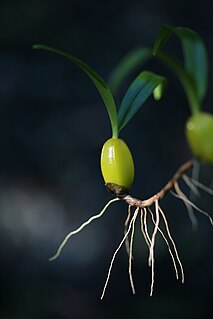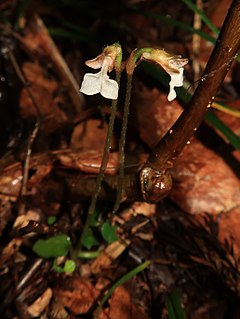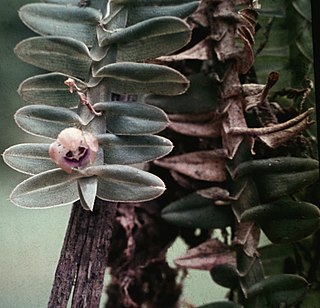
The Orchidaceae are a diverse and widespread family of flowering plants, with blooms that are often colourful and fragrant, commonly known as the orchid family.

The pseudobulb is a storage organ found in many epiphytic and terrestrial sympodial orchids. It is derived from a thickening of the part of a stem between leaf nodes and may be composed of just one internode or several, termed heteroblastic and homoblastic respectively. All leaves and inflorescences usually arise from this structure. Pseudobulbs formed from a single internode produce the leaves and inflorescence from the top, while those that are formed from several internodes can possess leaves along its length. The modified sheath leaves that appear at the base of a pseudobulb and often enfold all or part of it are usually dry and papery, though in some orchids the sheaths bear leaf blades and the leaves at the pseudobulb's apex are reduced to scales.

Dendrobium is a genus of mostly epiphytic and lithophytic orchids in the family Orchidaceae. It is a very large genus, containing more than 1,800 species that are found in diverse habitats throughout much of south, east and southeast Asia, including China, Japan, India, the Philippines, Indonesia, Australia, New Guinea, Vietnam and many of the islands of the Pacific. Orchids in this genus have roots that creep over the surface of trees or rocks, rarely having their roots in soil. Up to six leaves develop in a tuft at the tip of a shoot and from one to a large number of flowers are arranged along an unbranched flowering stem. Several attempts have been made to separate Dendrobium into smaller genera, but most have not been accepted by the World Checklist of Selected Plant Families.

Soursop is the fruit of Annona muricata, a broadleaf, flowering, evergreen tree. The exact origin is unknown; it is native to the tropical regions of the Americas and the Caribbean and is widely propagated. It is in the same genus, Annona, as cherimoya and is in the Annonaceae family.

Pinus muricata, the bishop pine, is a pine with a very restricted range: mostly in California, including several offshore Channel Islands, and a few locations in Baja California, Mexico. It is always on or near the coast.

Anacamptis morio, the green-winged orchid or green-veined orchid, is a flowering plant of the orchid family, Orchidaceae. It usually has purple flowers, and is found in Europe and the Middle East.

Isochilus is a genus of orchids with 13 recognized species. They are lowland epiphytes mainly found in Central America, from Cuba and Mexico to Argentina.

Kuhlhasseltia is a genus of orchids belonging to the subfamily Orchidoideae. It is native to China, Southeast Asia and New Guinea.

Dichaea is a genus of plants in family Orchidaceae. It contains about 100 species native to tropical America.
Resupination is derived from the Latin word resupinus, meaning "bent back with the face upward" or "on the back". "Resupination" is the noun form of the adjective "resupine" which means "being upside-down, supine or facing upward".

Dichaea glauca is a species of orchid.

Dichaea picta is a species of orchid.

Metalasia muricata (L.) D.Don, commonly known as 'White Bristle Bush' or 'Blombos', is a hardy virgate or twiggy shrub with honey-scented flowers usually 2–4 m tall, woody with a rounded crown, and an important component of the coastal and mountain fynbos regions of Southern Africa. It is encountered in a number of forms in its extended distribution, some of which are tolerant of frost, wind and poor sandy soils. A member of the Asteraceae or Daisy family, Metalasia has some 54 species in South Africa, many of them found in the Western Cape. The name of the genus Metalasia is derived from 'meta' which can have many meanings, but in this case is intended as 'reverse', and 'lasios' meaning 'woolly', an allusion to the woolly reverse sides of the leaves; 'muricata' means warty with short, sharp points like the shell of the Murex. Metalasia is also found in KwaZulu-Natal, Free State, Eastern Cape and Lesotho.

Dendrobieae is a tribe in the subfamily Epidendroideae, in the family Orchidaceae.

Annonamine is a benzylisoquinoline alkaloid isolated from Annona muricata, a plant commonly used in folk medicine by indigenous communities in Africa and South America. Structurally, it contains an aporphine core featuring a quaternary ammonium group.

Zygopetalinae is an orchid subtribe in the tribe Cymbidieae with 418 species.
D. picta can refer to a number of different species. The specific epithet picta means 'painted.'

The flora of the Philippines includes several species of plants and plant-like organisms. At the very least, one-third of the more than 9,250 vascular plant species native to the country are endemic. There are, however, no plant families endemic to the country. The families of gingers, begonias, gesneriads, orchids, pandans, palms, and dipterocarps are particularly high in endemic species. For example, two-thirds of the 150 species of palms present in the country are found nowhere else in the world. There are over 137 genera and about 998 species of orchids so far recorded in the Philippines as of 2007.
Asterolasia muricata, commonly known as lemon star-bush, is a species of small, slender, erect shrub that is endemic to South Australia. It has leathery leaves covered with rough points and with the edges rolled under, and yellow flowers arranged singly or in groups of up to three, with woolly star-shaped hairs on the back of the petals.

Eulophia obtusa, a showy and distinctive species of orchid, popularly known as the ground orchid, recorded from Bangladesh, North India and Nepal. This orchid growing in seasonally in grassland. It is a grass associated orchid species. A Bangladesh based renowned botanist and ornithologist Md Sharif Hossain Sourav first described this rare species from Bangladesh in 2017. There are only three collections in the Kew Herbarium dates from 1902, which suggests that it is quite a rare species. It is as critically endangered (CR) in Bangladesh according to the IUCN Red Listing criteria. Very recently this species rediscovered from India after 118 years.

















